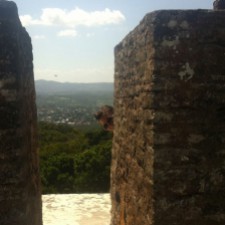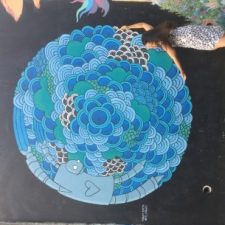Discussion:
You must be logged in to reply to this topic.
- 9.19.16: Response 2
-
August 19, 2016 at 11:01 am #37840

Nora AlmeidaParticipantWrite a 100 word summary of the book you borrowed. What topics does the book cover? What sources does the book reference?
September 11, 2016 at 10:30 pm #38794
Victor RamirezParticipantBadger’s Illustrated Catalogue of Cast-Iron Architecture
By Daniel D. Badger
(The Architectural Iron Works of the City of New York)I have chosen this book about Cast-Iron Architecture in New York as a point of reference for the architecture of the early 1840s. The American Daniel D. Badger is one of many pioneers of cast-iron architecture in the United States.
Daniel D. Badger founded a company called Architectural Iron Works that manufactured iron shutters (movable iron windows) at 44 and 46 Duane Street, N.Y. He incorporated cast-iron work into the storefronts of Greek Revival Buildings that previously used granite material in their post-lintel-system.
Badger’s company became very successful in the iron industry. In 1865, he published a catalogue of cast-iron post-lintel-systems, ornaments that architects were eager to use in their façade designs.
Since this class is about learning about places in New York City, I am curious about the ornamental details that many New York City Landmarks have. For instance, Grand Central Depot 1871, designed by John B. Snook, had a train shed designed by Issac C. Buckout. The shed was built by Architectural Iron Works and it was considered a masterpiece of architecture at the time.
Badger’s book illustrates his architectural iron works done in many buildings, including the owner’s names. Each illustration has a number in the catalogue details called a “plate” with Roman numbers. Also, each illustration has a number that refers to the detail’s name.
Today the ornamental details for buildings are not made of cast-iron, but they retain the original style from Badger’s company. Many buildings were erected during the late 1800s and there are a few that survived. These surviving buildings preserve the original cast-iron ornaments and today they are considered New York City Landmark buildings.
This book is definitely worth reading. It gives the reader a better understanding of the ornamental details used in many of the landmark building throughout the five boroughs of New York City.
September 12, 2016 at 1:41 am #38810
neil85ParticipantGrand Central …the World’s Greatest Railway Terminal Summary.
The book starts to talk about the coming of the railroad to Manhattan and the different companies that owned them. Then, Cornelius Vanderbilt’s change of heart from steamboat to railroad business and how he acquired and consolidated the different lines owned by different companies. Engineers and architects with their designs and work was mentioned as well. The book also talks about the construction, design, location and switch from Depot to Station then finally to Terminal. At the end the book gives a future projection of Grand Central Terminal and mentions the various lines/companies associated with Grand Central Terminal like the MTA, LIRR AND AMTRAK.September 17, 2016 at 4:30 pm #39001
sotir zhupaParticipantThe book that I chose to read for this assignment is “freehand sketching” by Paul Laseau. This book discusses the essentials and gives tips on how to improve your freehand sketching and drawing. It talks about a variety of things that are needed to draw better ranging from your hand positioning to shading, which can give depth to your sketches. I chose to read this book because I am pretty bad at sketching and would like to improve on it. This book references other drawing books as well as architecture books.
September 17, 2016 at 9:08 pm #39007
Victoria CotisParticipantBook Title: I Never Knew That About New York
Author: Christopher Winn
Book Report 1The book that I chose was called ” I never knew that about New York” by Christopher Winn. This book started at the southern tip of Manhattan, with the opening chapter entitled New York Harbor, where New York began. In 1898, five neighboring cities or boroughs build up to form the City of Greater New York. They were New York (Manhattan), Brooklyn, Queens, the Bronx, and Staten Island. They all have their own unique history. This book walk along Broadway, New York oldest road ‘Main Street’ from south to north. Each chapter has an interesting and most fascinating story of the city and its history.
September 17, 2016 at 10:35 pm #39008
SIN FONG CHIUParticipantName of the book: The Golden Ratio
Author: Mario LivioProfessor mentioned Golden Ratio on his first lesson, and I was hopping I could find something more interesting. I studied mathematics, but I was not sure how golden ratio could be applied to architecture, so I borrowed this book. In this day we know the Golden ratio exist in nature from as small as human DHA to as lager as the galaxy. The matter of fact that the ancient Greeks knew about Golden ratio in two thousand years ago. They build a very famous temple called the Parthenon. Also,Egyptian knew how to use golden ratio. Scientist found out that the pyramid had almost the perfect golden ratio. We are talking about 0.01% difference, which is amazing.
September 18, 2016 at 12:11 pm #39011
Joyce TamParticipantThe Architecture of New York City by Donald Martin Reynolds discusses the history and perspectives of various important symbols, sites and structural icons in New York City. In the chapter “The New York Port Comes of Age”, it speaks of the Beaux-Art Cladding, symbiosis of sculpture and architecture, public transportation, and Grand Central. Various sections mentions Cass Gilbert and his derived Beaux Arts style, Vanderbilt and the landscape of New York City at the time and its relations to public transportation, and the transition from a Grand Central Depot to Station to Terminal.
September 18, 2016 at 2:57 pm #39018
Noorul AinParticipantBook Name: Grand Central Terminal
Author: Kurt C. SchlichtingThe book I choose was the “Grand Central Terminal”. This book talks about how the creation of Grand Central, brings together a numbers of themes of New York’s history. The urban change, the brilliant creation of engineers and the dynamic influence of technology on history. The book has four chapters the first is, “The Commodore’s Grand Central” in which author writes about how in nineteenth century New York was becoming the residential and commercial area. In this era the form of transportation appeared was steam train services in lower Manhattan.
The 2nd chapter is “ The Engineer’s Grand Central ” which talks about how engineers build a massive Grand central by introducing two level tracks and electrified trains. And how it transformed the train services. The 3rd chapter is “The Architect’s Grand Central” which shows how Architecture of that era builds the great sculpture and beautiful deigns of the Grand Central. And the last chapter is “ New York’s Grand Central” which shows how this big creation has been use since then for so many people of New York City as a transportation service. Each chapter tells you specific details about how Grand Central transforms New York City in the way it is now.September 18, 2016 at 8:38 pm #39025
Richard LokParticipantBook Name: Rail Under The Mighty Hudson
Author Name: Brian J. CudahyIn the late nineteenth century, there have been several attempts to build rail tunnels under the Hudson River connecting New Jersey and New York. Due to financial and technical issues, construction kept going on and off. In the early twentieth century, William Gibbs McAdoo, a man with a background in legal training and railroading, took it upon himself to finish building the Hudson tunnels. He started the company, Hudson and Manhattan Railroad that built two of the tunnels. He would later on serve as U.S. Secretary of the Treasury and soon be elected to become a United States Senator for the state of California. Hudson and Manhattan Railroad would then become the PATH System of the Port Authority of New York and New Jersey. In 1910, the Pennsylvania Railroad opened one of the tunnels that operate through Penn Station at Eighth Avenue and 33rd Street. The tunnel is currently being used by both the Amtrak and New Jersey Transit trains.
September 18, 2016 at 8:50 pm #39026
TShieldsParticipantBook Name: Guide to New York City Landmarks New York City Landmarks Preservation Commission Forth Edition
Edited by: Matthew AS. Postal
Text by: Andrew S. Dolkart / Matthew A. PostalMy book is, as the title states, a guide book to the landmarks in New York City. It has grids of the many historical districts in the different boroughs and also individual sites to see. The book is very interesting to me because I’m a big fan of being a “tourist” in my own city. There is never really enough to see and always something new to find in New York City. I haven’t come across sources in this book as of yet. Currently I’m reading up on the landmarks in Harlem, which I believe are very important for the younger generation to know about so they can grasp what Harlem was then and what it is now.
September 18, 2016 at 9:23 pm #39028
NagisaParticipantBook Name: Grand Central Terminal
Author: Kenneth PowellThis book discusses how the Grand Central was built and developed architecturally. The Grand Central built at the beginning of the century, it exemplifies the ideals and aspirations of a great American city emerging as a world metropolis in the decade before World War I. It still embodies a practical and progressive vision of urban life, which has new relevance in the aftermath of the Modern Movement. This book presents the building in detail, using drawings, and archival and recent photography.
September 19, 2016 at 11:15 am #39043
Maryse MauriceParticipantBOOK TITLE: Conquering Gotham
A gilded age epic:
The construction of Penn Station and its tunnels
Author: Jill JonnesJill Jonnes tells a great tale about corporate leaders, engineers and politicians, and sacrifice workers who brought the station to life in 1910. Conquering of Gotham is more about Penn Station and how they wanted to make an easily accessible to the people on the other side of the Hudson river. the book covers the corruption of Tammany Hall. Alexander Cassatt was the President of the Pennsylvania Railroad Station. He determined that it was possible to build the tunnels to connect Manhattan to New Jersey and long Island. Cassatt’s plans of construction of the tunnels involved not only engineering problems, but also confronted Tammany Hall. Conquering Gotham addressed some serious topic, such as success and Failures.
September 19, 2016 at 4:49 pm #39060
Nora AlmeidaParticipantExceptional range of topics about or intersecting with Grand Central Terminal. For these summaries we can see that Grand Central touches on many disciplines from history to math to engineering to architecture.
September 19, 2016 at 11:19 pm #39063
Jesus MendozaParticipantBook Title: Drawing Architecture and the Urban
Author: Sam JacobyThis book has quite a deceiving title. You open up the book and begin to think, “Wow this book will be great at teaching me how to draw”. Then you begin reading it and realize this is a goldmine of pure architectural terminology. The book is split into four different parts starting with conventions and ending with transformations. The book is also filled with various illustrations ranging from planes and lines all the way into orthographic projections and computer assisted designs. You learn a lot about how architectural sketching went from purely by hand and soon morphed into what we know now as graphically and computer assisted. The author actually references all the help he got at the beginning of the book. The book was written with the help of many architects and professors of the subject itself. It also references what other books can be used alongside with this book when conducting research. Although a lot of the terminology in this book will not be used in class it is still nice to know what’s on the surface of the subject.
September 20, 2016 at 10:45 am #39066
Bryan OrtizParticipantBook Title: Gentlemen Bankers: The World of J. P. Morgan.
Author: Susie J. Pak
Rather than do a simple autobiography about the famous banker J. Pierpont Morgan, this book talks about the business world in the times of Morgan, and how he influenced New York’s growth. As I read, the book had charts, graphs, and other pieces of information that show the profits and influence Morgan and his partners made. All the refernces that the author used was at the end of the book, and was over 100 pages of refernces. Since it’s about J.P Morgan, it’s going to hold records and trasactions that he made. I will defenitely use this information I got to understand the business of cooperations.
You must be logged in to reply to this topic.


